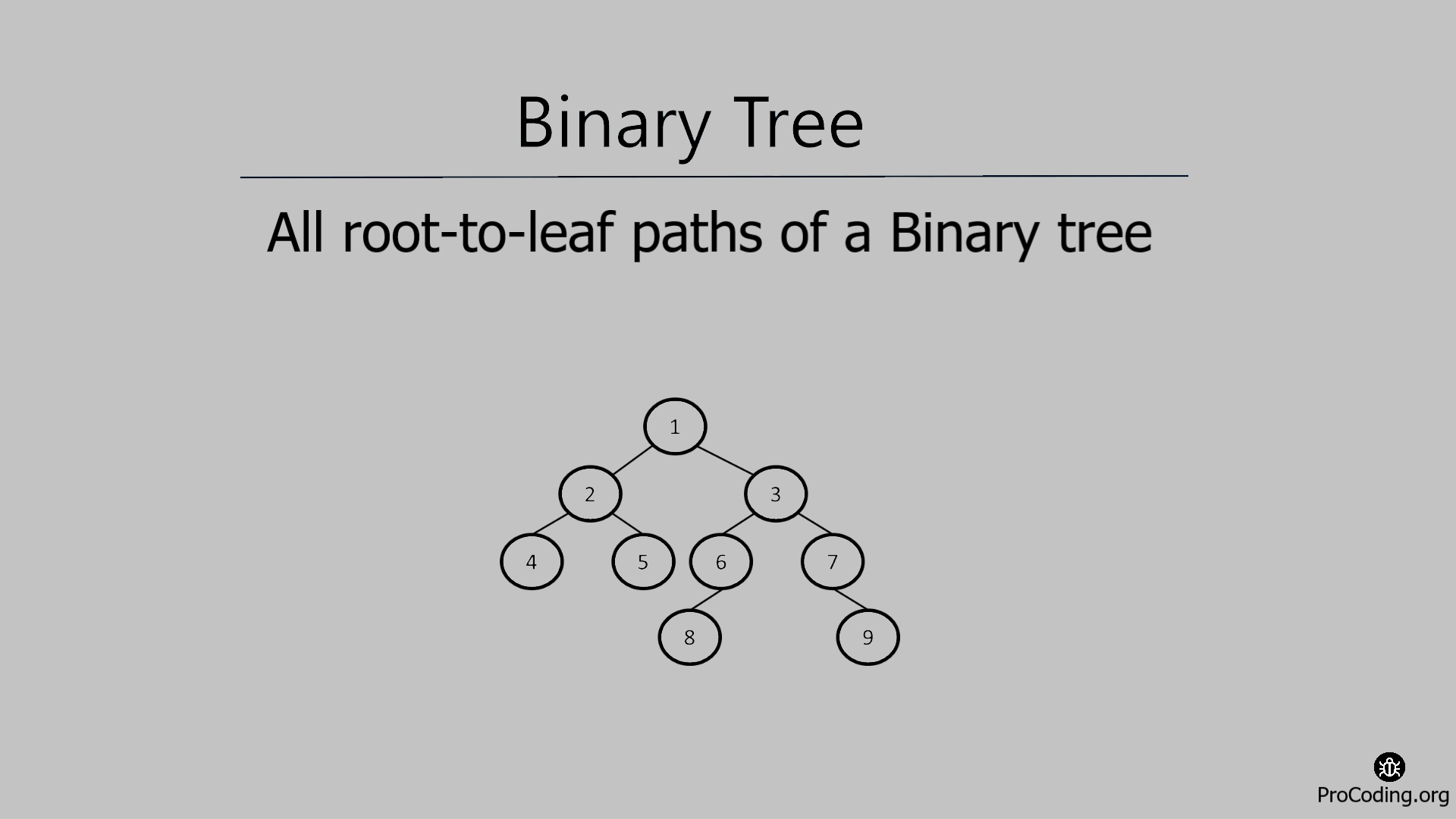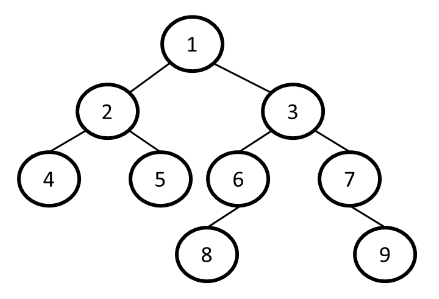All root-to-leaf paths of a Binary tree
Category: Data Structures
Write a program to find all root to leaf paths of a Binary tree. A tree has different paths from the root to each leaf node, print all the possible paths from the root to each leaf node separately.

All root-to-leaf paths of a Binary tree
A tree has different paths from the root to each leaf node. We have to print all the possible paths from the root to each leaf node separately.

For this graph all possible root to leaf paths are
- 1 -> 2 -> 4
- 1 -> 2 -> 5
- 1 -> 3 -> 6 -> 8
- 1 -> 3 -> 7 -> 9
Example -
Input:
1
/ \
2 3
/ \ / \
4 5 6 7
Output:
1 -> 2 -> 4
1 -> 2 -> 5
1 -> 3 -> 6
1 -> 3 -> 7
Solution
For the solution, we have to traverse each node recursively and find all the possible paths for each leaf node from the root.
Python
class Node:
def __init__(self, data):
self.left = None
self.data = data
self.right = None
def path_finder_util(root, string, paths):
if not root: return
string += str(root.data)
path_finder_util(root.left, string+'->', paths)
path_finder_util(root.right, string+'->', paths)
if not root.left and not root.right:
paths.append(string)
def path_finder(root):
if not root:
print("")
return
paths = []
path_finder_util(root, '', paths)
for path in paths:
print(path)
root = Node(1)
root.left = Node(2)
root.right = Node(3)
root.left.left = Node(4)
root.left.right = Node(5)
root.right.left = Node(6)
root.right.right = Node(7)
root.right.left.left = Node(8)
root.right.right.right = Node(9)
path_finder(root)
JavaScript
class Node {
constructor(data) {
this.left = null;
this.data = data;
this.right = null;
}
}
function pathFinderUtil(root, string, paths) {
if (root == null) return;
string = string + root.data;
pathFinderUtil(root.left, string + "->", paths);
pathFinderUtil(root.right, string + "->", paths);
if (root.left == null && root.right == null) {
paths.push(string);
}
}
function pathFinder(root) {
if (root == null) {
console.log("");
return;
}
let paths = [];
pathFinderUtil(root, "", paths);
for (let path of paths) {
console.log(path);
}
}
const root = new Node(1);
root.left = new Node(2);
root.right = new Node(3);
root.left.left = new Node(4);
root.left.right = new Node(5);
root.right.left = new Node(6);
root.right.right = new Node(7);
root.right.left.left = new Node(8);
root.right.right.right = new Node(9);
pathFinder(root);
Output
1->2->4
1->2->5
1->3->6->8
1->3->7->9
In the above program, we have printed all the root-to-leaf paths as a string but we may need all paths as a list to process further in that case we can use the following program.
Python
class Node:
def __init__(self, data):
self.left = None
self.data = data
self.right = None
def path_finder_util(root, path, paths):
path.append(root.data)
if root.left:
path_finder_util(root.left, path, paths)
if root.right:
path_finder_util(root.right, path, paths)
if not root.left and not root.right:
# store the copy of list to avoid referencing older list
paths.append(path.copy())
path.pop() # remove last node to backtrack
def path_finder(root):
if not root:
print([])
return
paths = []
path_finder_util(root, [], paths)
for path in paths:
print(path)
root = Node(1)
root.left = Node(2)
root.right = Node(3)
root.left.left = Node(4)
root.left.right = Node(5)
root.right.left = Node(6)
root.right.right = Node(7)
root.right.left.left = Node(8)
root.right.right.right = Node(9)
root = None
path_finder(root)
JavaScript
class Node {
constructor(data) {
this.left = null;
this.data = data;
this.right = null;
}
}
function pathFinderUtil(root, path, paths) {
path.push(root.data);
if (root.left) {
pathFinderUtil(root.left, path, paths);
}
if (root.right) {
pathFinderUtil(root.right, path, paths);
}
if (root.left == null && root.right == null) {
// store the copy of list to avoid referencing older list
paths.push([...path]);
}
path.pop(); // remove last node to backtrack
}
function pathFinder(root) {
if (root == null) {
console.log([]);
return;
}
let paths = [];
pathFinderUtil(root, [], paths);
for (let path of paths) {
console.log(path);
}
}
const root = new Node(1);
root.left = new Node(2);
root.right = new Node(3);
root.left.left = new Node(4);
root.left.right = new Node(5);
root.right.left = new Node(6);
root.right.right = new Node(7);
root.right.left.left = new Node(8);
root.right.right.right = new Node(9);
pathFinder(root);
Output
[1, 2, 4]
[1, 2, 5]
[1, 3, 6, 8]
[1, 3, 7, 9]